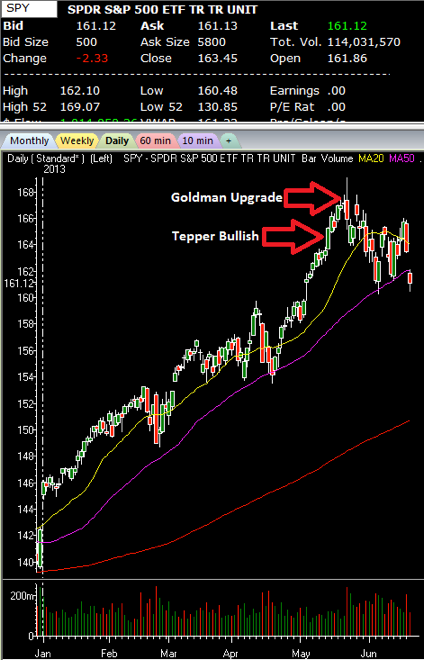On May 14, 2013, David Tepper, head and founder of Appaloosa Management appeared on CNBC and told the world he felt the markets would continue dramatically higher for the rest of the year.
One week later, Goldman Sachs (GS) upgraded its price targets on the S&P 500 for 2013 and 2014. The very next day, the stock market topped as the SPDR S&P 500 ETF Trust (SPY) hit a high of $169.07 before reversing the same day to close at $165.93.
Volume Gave It Away
That reversal was a clear signal of a top in the market because of the volume. The volume surge on that day was the biggest volume in all of 2013. Volume and major reversals coming at an all time high almost always signal a strong pullback on the horizon.
Why Do They Do it?
In early 2008, Goldman Sachs upgraded oil to $200 per barrel. Back then, Oil was trading near $150. Guess what? Oil hasn't breached that price since. Again, Goldman Sachs upgraded an investment vehicle at its exact high, which has been repeated by countless analysts, hedge-fund heads, institutional CEO's and more. So why do the big boys always upgrade things at their exact tops, only to see the bottom fall out?
There are two possible reasons. First, they really are no better than the average investor, getting caught up in the hype of any move. However, if this was true, these institutions would not be raking in billions of Dollars in profits per quarter. The only other possibility is they are using the hype and upgrade to sell into it, knowing the top is at hand.
Dumping Into The Top
These big boys understand economics, they understand hype and emotion, they get paid millions to know the odds and be on the right side of the trade. In that case, the only alternative is to assume these big players upgrade markets or stocks at their highs to get the small investor to buy, thus dumping into it. The small investor, time and time again is left holding the bag. If this is true, it would be the biggest scandal yet to hit Wall Street.
Any investigator can look at every major spike or drop in any market and notice a coinciding upgrade and downgrade. Yet with all these bad calls, institutions continue to rake in billions in profits. Is it any wonder the small investor trusts the markets less and less?
Gareth Soloway
Chief Market Strategist
www.InTheMoneyStocks.com
- English (UK)
- English (India)
- English (Canada)
- English (Australia)
- English (South Africa)
- English (Philippines)
- English (Nigeria)
- Deutsch
- Español (España)
- Español (México)
- Français
- Italiano
- Nederlands
- Português (Portugal)
- Polski
- Português (Brasil)
- Русский
- Türkçe
- العربية
- Ελληνικά
- Svenska
- Suomi
- עברית
- 日本語
- 한국어
- 简体中文
- 繁體中文
- Bahasa Indonesia
- Bahasa Melayu
- ไทย
- Tiếng Việt
- हिंदी
Upgrading At The Top: Why It's Done
Latest comments
Loading next article…
Install Our App
Risk Disclosure: Trading in financial instruments and/or cryptocurrencies involves high risks including the risk of losing some, or all, of your investment amount, and may not be suitable for all investors. Prices of cryptocurrencies are extremely volatile and may be affected by external factors such as financial, regulatory or political events. Trading on margin increases the financial risks.
Before deciding to trade in financial instrument or cryptocurrencies you should be fully informed of the risks and costs associated with trading the financial markets, carefully consider your investment objectives, level of experience, and risk appetite, and seek professional advice where needed.
Fusion Media would like to remind you that the data contained in this website is not necessarily real-time nor accurate. The data and prices on the website are not necessarily provided by any market or exchange, but may be provided by market makers, and so prices may not be accurate and may differ from the actual price at any given market, meaning prices are indicative and not appropriate for trading purposes. Fusion Media and any provider of the data contained in this website will not accept liability for any loss or damage as a result of your trading, or your reliance on the information contained within this website.
It is prohibited to use, store, reproduce, display, modify, transmit or distribute the data contained in this website without the explicit prior written permission of Fusion Media and/or the data provider. All intellectual property rights are reserved by the providers and/or the exchange providing the data contained in this website.
Fusion Media may be compensated by the advertisers that appear on the website, based on your interaction with the advertisements or advertisers.
Before deciding to trade in financial instrument or cryptocurrencies you should be fully informed of the risks and costs associated with trading the financial markets, carefully consider your investment objectives, level of experience, and risk appetite, and seek professional advice where needed.
Fusion Media would like to remind you that the data contained in this website is not necessarily real-time nor accurate. The data and prices on the website are not necessarily provided by any market or exchange, but may be provided by market makers, and so prices may not be accurate and may differ from the actual price at any given market, meaning prices are indicative and not appropriate for trading purposes. Fusion Media and any provider of the data contained in this website will not accept liability for any loss or damage as a result of your trading, or your reliance on the information contained within this website.
It is prohibited to use, store, reproduce, display, modify, transmit or distribute the data contained in this website without the explicit prior written permission of Fusion Media and/or the data provider. All intellectual property rights are reserved by the providers and/or the exchange providing the data contained in this website.
Fusion Media may be compensated by the advertisers that appear on the website, based on your interaction with the advertisements or advertisers.
© 2007-2025 - Fusion Media Limited. All Rights Reserved.
